What is Zero-Party Data and Why is it Important?
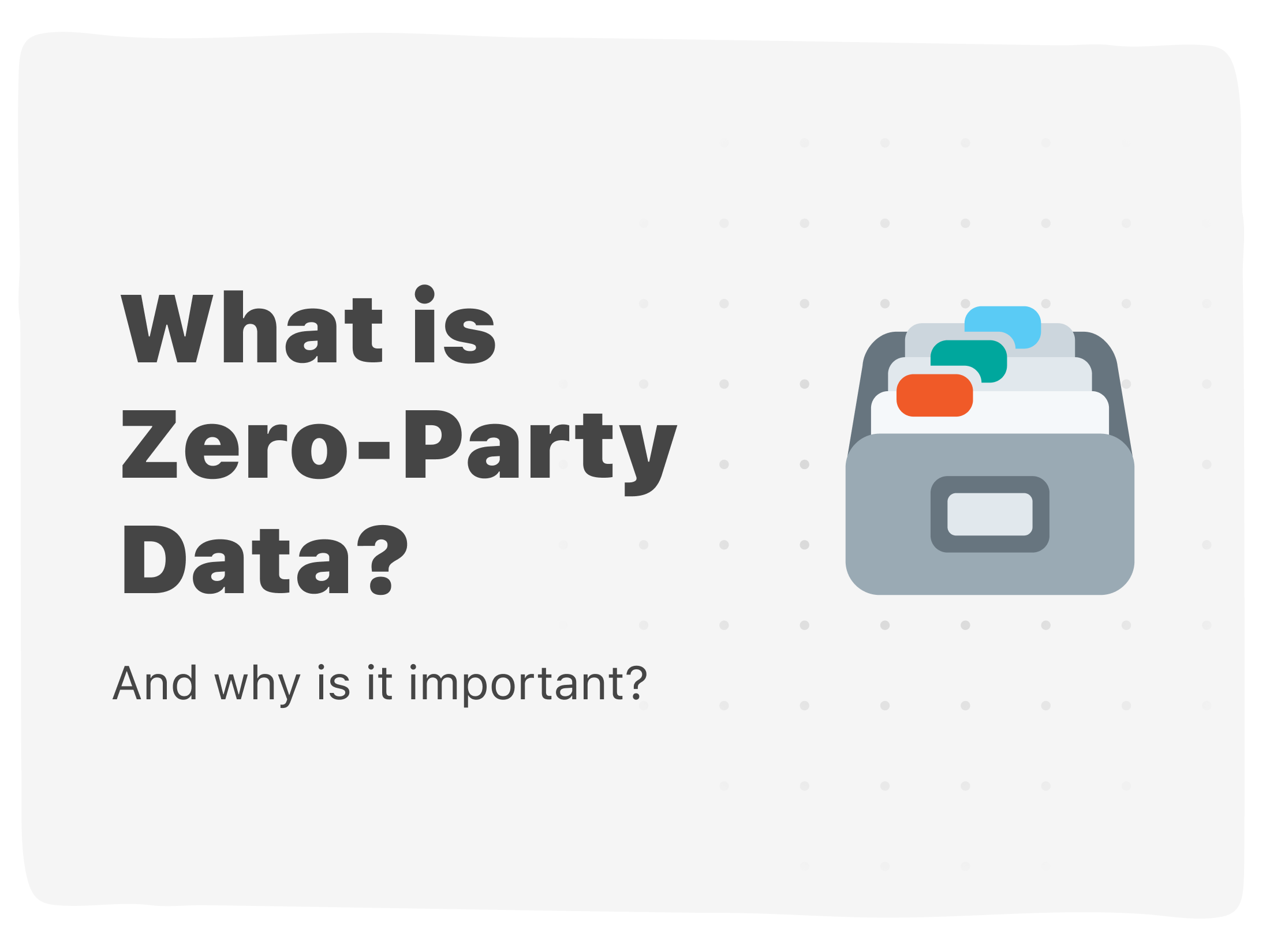
Consumers are increasingly skeptical of how their data is gathered and what it’s used for. Legislation such as GDPR and the CCPA have brought data privacy issues to the forefront of consumers’ minds.
This poses a serious issue for online retailers who need to respect consumer privacy while being faced with the responsibility to provide personal, relevant and memorable experiences.
Finding a way to balance both privacy and customer experience (CX) is becoming increasingly important, especially in light of the ongoing third-party cookie apocalypse.
Which is where the difference between different types of customer data come into play. In this article, we’ll dive deeper into the differentiation of these types of data, and show you exactly why and how you should be doubling down on zero-party data.
Table of contents
A brief overview of customer data
1. What is third-party data?
What are first-party and third-party cookies?
2. What is second-party data?
3. What is first-party data?
4. What is zero-party data?
Why is zero-party data important?
How do I collect zero-party data?
Great examples of zero-party data collection
Instagram poll
Facebook and Instagram posts
Email
Omni Opt-in Alerts
A brief overview of customer data
Customer data is the information you’ve collected from your websites, apps, physical stores or other situations where people have shared information with you, such as in emails, surveys or messaging apps.
There are a bunch of different types of customer data, but common ones include:
- Email addresses
- First names
- Last names
- Phone numbers
- Countries of residence
- Sizes (shoes, clothing, etc.)
- Other preferences
It’s important to note that customer data can be collected in several different contexts. We can divide these contexts into the following categories:
- Third-party data
- Second-party data
- First-party data
- Zero-party data
These categories of data collection differ in the way the data ends up in the hands of the company doing the collecting. This ranges from completely non-consensual and operating in the background, all the way to being freely and actively shared by consumers.
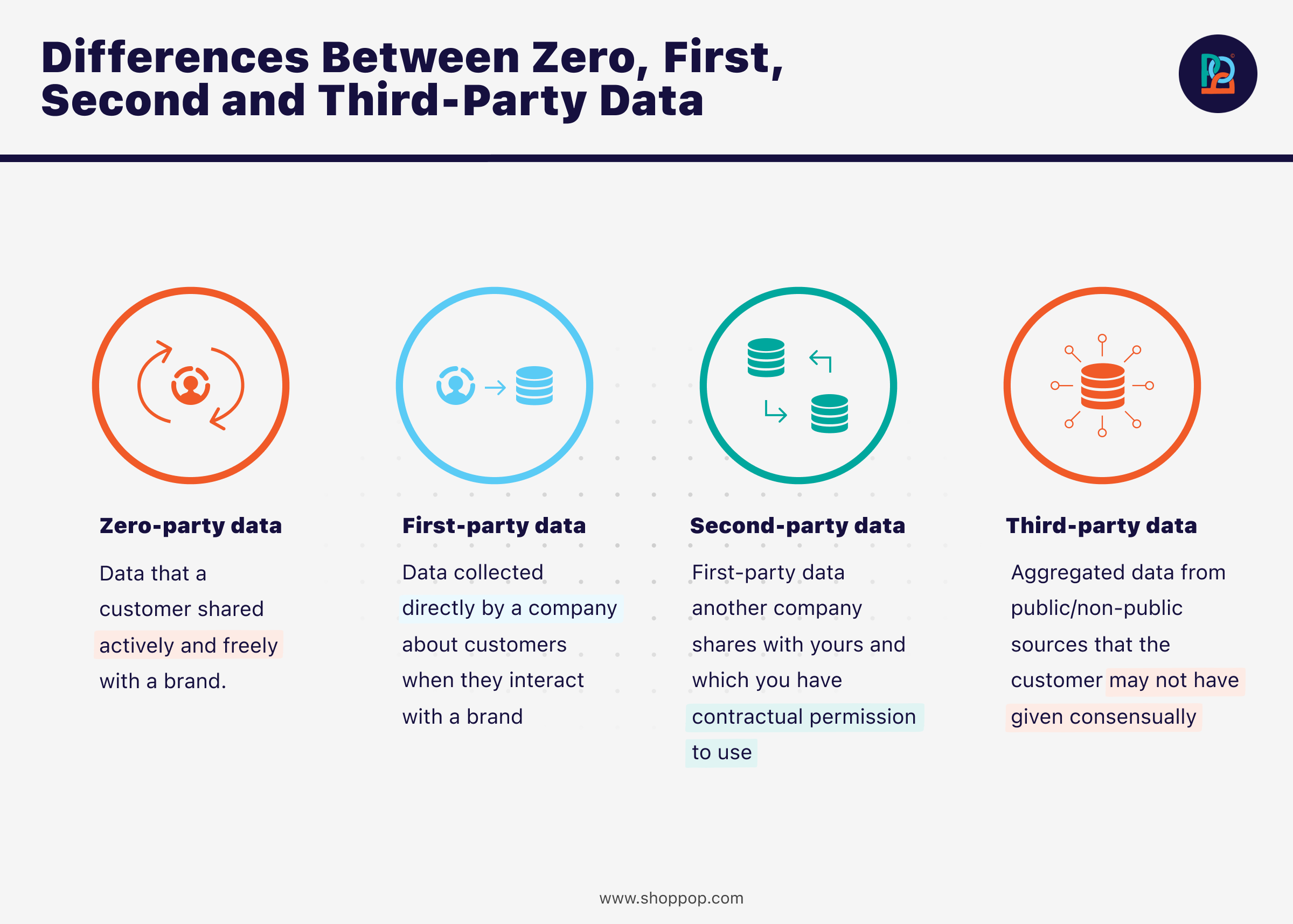 Differences between customer data types
Differences between customer data typesLet’s take a closer look at each category of customer data collection.
1. What is third-party data?
This type of data collection is far removed from being consensual on the part of the user whose data is actually being collected. Third-party data is usually collected from a variety of sources, and aggregated by a third-party company. These companies are called data management platforms (DMPs).
DMPs take this data, aggregated from all sorts of websites and apps, and turn it into elaborate user profiles. These profiles are then sold again to other companies or brands which then use them in their marketing campaigns.
As you might imagine, consumers are mostly unaware that this is happening at all. One of the ways in which DMPs gather third-party data is through the use of third-party cookies.
What are first-party and third-party cookies?
There are two types of cookies: first-party and third-party cookies. First-party cookies collect data that can be only accessed by the website the user is visiting.
Third-party cookies are cookies on a website set up by yet another (third-party) website. These cookies are shared between web domains, so social media networks and advertisers can target ads to users based on websites they’ve recently visited.
Recently, there have been a lot of changes to the way browsers and mobile devices allow these third-party cookies to track you:
- GDPR and CCPA. These regulations have given end-users more control over what type of cookies they accept when visiting a website.
- Google and Apple. Chrome and Safari, the world’s most-used browsers, so that they no longer allow third-party cookies to track you by default.
- App Tracking Transparency. This update to iOS makes users give explicit permissions for cross-app tracking.
All of these changes are meant to protect consumers from third-party data collection practices, meaning more privacy and less non-consensual data capturing.
Want to read more? Read this article on the future of private and consent-based marketing on our blog.
2. What is second-party data?
This type of data collection is a bit simpler. Second-party data is basically first-party data you buy from another company. As opposed to third-party data, where you buy an aggregated data set from a company that collected it from all sorts of sources.
There are quite a few use cases in which you might imagine buying another company’s data. Imagine you run an online store that sells nutrition supplements, like Tenergy Nutrition, but you’re finding it difficult to figure out who to target ads to.
In this case, you could approach another online store selling, say, gym clothes and workout wear. Their customers will have very similar interests to yours, and are already used to buying products online.
You could approach this store and ask them to sell their first-party customer data to you, directly. This means you’ll know the data is of high quality and you’ll be able to make an agreement and purchase just the data relevant to your business.
The transfer of first-party data to a different owner is what makes it second-party data.
Still, customers will rarely be informed of this transaction having taken place at all, let alone given permission for the reselling of their data.
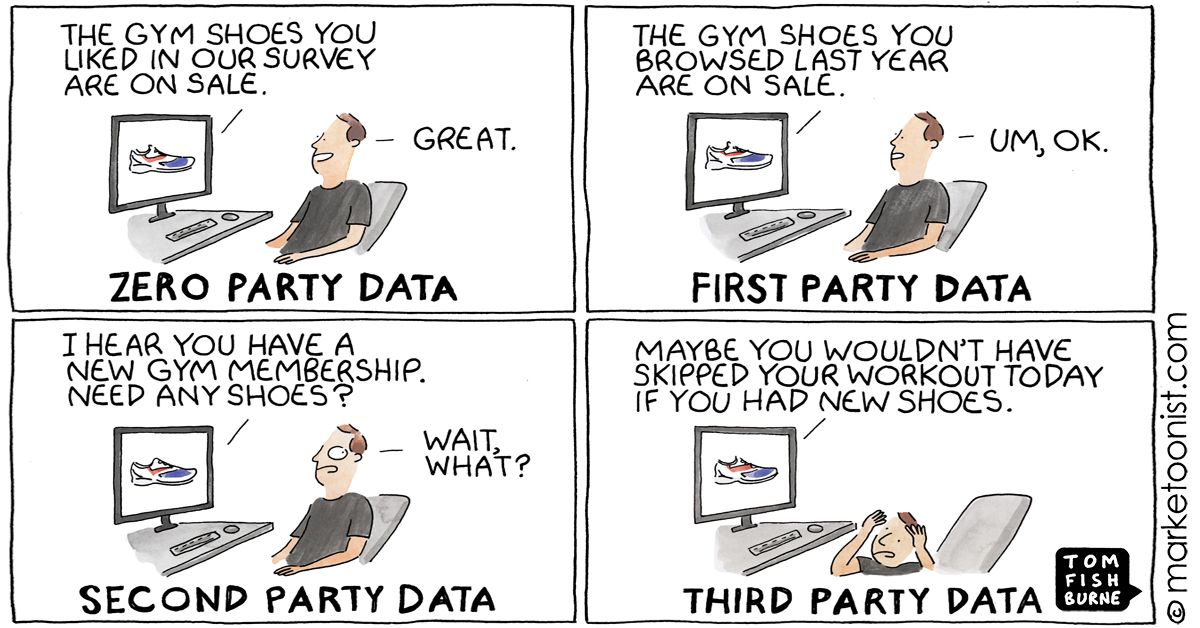 Source: Marketoonist
Source: Marketoonist3. What is first-party data?
First-party data is the type of customer data a business actually owns. It’s collected directly from customers or audiences visiting and using a business’ websites, apps or products.
This type of data is usually of high quality, very detailed, and collected within the context of your own business. As such, this is the type of data best suited to create tailored and personalized experiences your customers will love.
There are three types of first-party data:
- Relational and transactional. Things like your customers’ personal details and purchase history. The type of data you’ll find in your CRM.
- Interactional. First-party data derived from your customers interacting with your business, such as on your website, in messaging apps, or through email.
- Behavioral. Data derived from what your customer does. This includes things like scroll depth on a product page or cart abandonment.
First-party data is essential to creating a customer-centric business model.
For example: your interactional first-party data might include a higher than average number of complaints or returns about specific products. Using this data to improve these products is a business practice that benefits both your business and your customers.
According to a Merkle's 2021 Customer Engagement Report:
- 41% of marketers say digital media activation will be the area most impacted due to the rise of privacy-related data restrictions
- 88% of marketers say collecting first-party data is a 2021 priority
- While first-party data is at the top of the agenda for marketers in 2021, the report also points to the need for marketers to increase the acquisition of zero-party data
So let’s take a closer look at the most important type of customer data: zero-party data.
4. What is zero-party data?
Zero-party data (ZPD) is data intentionally, (pro-)actively and freely shared by a customer with a business or brand. This type of data is collected through explicit and direct interaction with customers, in for instance, surveys, questionnaires, emails or messaging app conversations.
The best thing about zero-party data is it provides companies with the data they need to create personalized experiences customers love. While at the same time ensuring customers are happy about how the data was collected and how it will be used.
 The four types of customer data
The four types of customer dataWhy is zero-party data important?
Research and advisory company Forrester’s VP principal analyst, Fatemeh Khatibloo, says that, for businesses:
“Zero-party data is gold … [w]hen a customer trusts a brand enough to provide this really meaningful data, it means that the brand doesn’t have to go off and infer what the customer wants or what [their] intentions are.”
If we were to sum up the characteristics of zero-party data, you could say it’s:
- Direct
- Private
- Trust-based
- Self-reported
- Consent-based
Sure, you could go and purchase another company’s first-party data and use it to infer that company’s customers intentions. But is this going to give you the same high-quality results as using zero-party data?
Example of using second-party data:
You own a running shoe company and you buy an athletic clothing company’s first-party data. You use this dataset as second-party data to run ads to people that might be interested in buying your running shoes.
Even though there’s a likelihood people interested in athletic clothing would also be interested in running shoes, this is mostly hypothetical and based on your assumptions at best. You can optimize your ads, but you’re still running a spray-and-pray marketing strategy.
Now compare this to...
Example of using zero-party data:
Someone visits your online running shoe store. They’re looking for a very specific pair of shoes. In the search box, they type: “dark blue adidas originals swift 11”
The search results show all the products corresponding to these terms, but also an unintrusive pop-up or drop down banner appears asking:
“Would you like to receive an alert when we add new Adidas shoes to our collection?”
Or
“Would you like to receive a WhatsApp notification when Adidas Originals go on sale?”
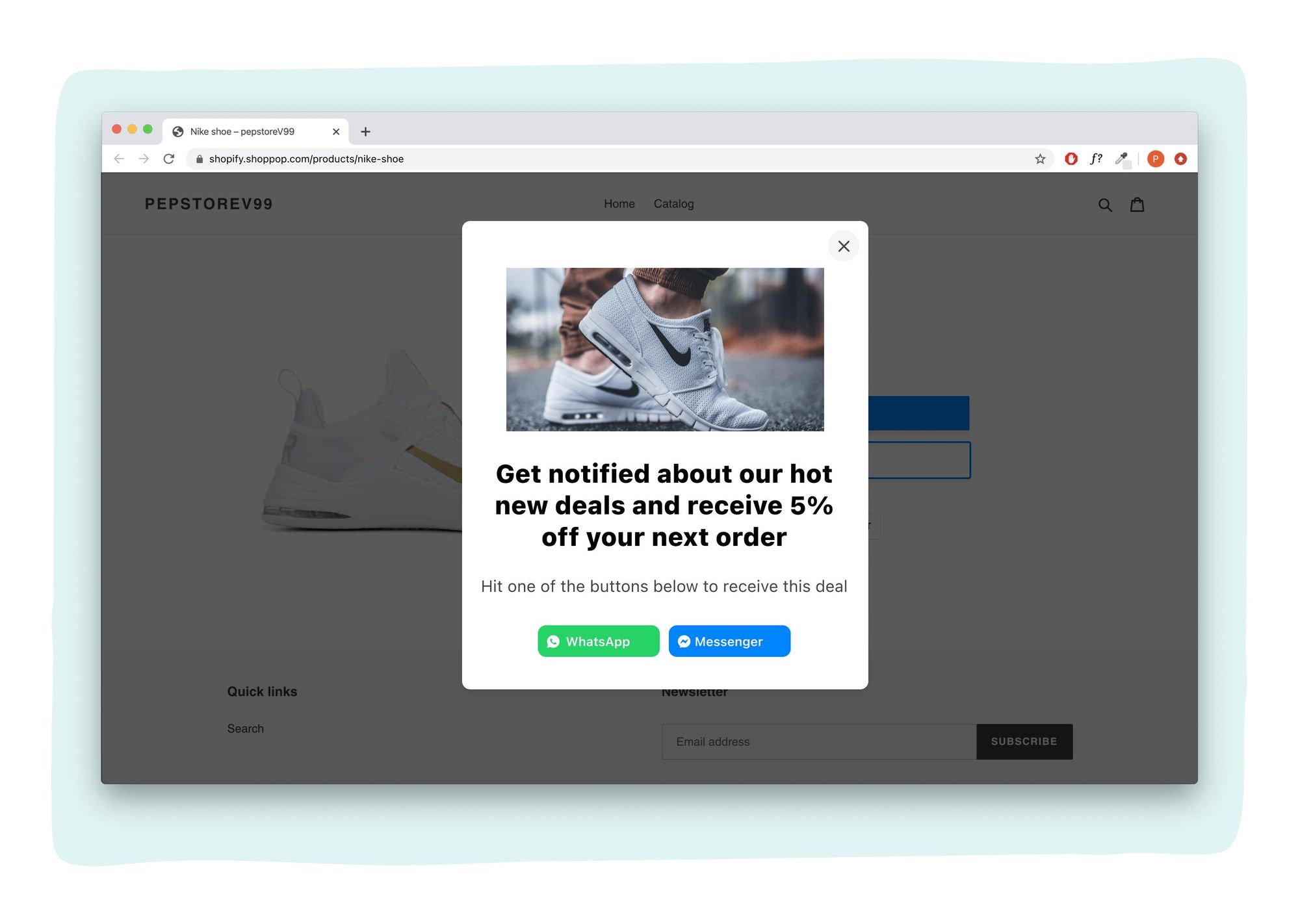 Collecting zero-party data by building WhatsApp lists
Collecting zero-party data by building WhatsApp listsCustomers that answer yes to either of these questions are providing you with zero-party data. They are telling you about their preferences in a direct, intentional, proactive and consent-based way.
How do I collect zero-party data?
There are several ways you can tap into customers’ valuable zero-party data, as long as you pay attention to a few important details:
- Zero-party data collection is consent-based
- You should be explicit about what will happen to this data
Remember: the main reason customers part with their data actively and voluntarily is their desire for personalization. Explicitly mention how your use of the data you collect ties into a better understanding of your customers’ needs. Show them you will use this data to create a smoother experience for them.
Regarding ways in which you can collect zero-party data, we suggest trying one or several of the following:
- Social media polls
- Interactive quizzes and games
- In-store through loyalty programs
- Preference centers in a new user’s onboarding process
- Sale or filter alerts prompted by on-site or in-app searches
- Conversations with customer support employees (chat, email, or phone)
- Surveys shared in emails, messaging apps, or other communication channels
Of course, even though customers give you this information freely and intentionally, there’s still no way to guarantee that it is 100% accurate. A final tip on collecting zero-party data is to try not to ask too much information from your customers.
By limiting the amount of zero-party data you request, you make it easier for customers to give you what you’re asking for.
Great examples of zero-party data collection
Now we’ve listed the many ways in which you can collect zero-party data, let’s zoom in on some actual use cases. Hopefully, these will inspire you to start your own zero-party data collection campaigns.
Instagram poll
There’s a poll feature on Instagram Stories that allows businesses to engage with their followers in fun and creative ways. They're a great way to interact with your audience in general, but even better at helping you collect valuable, self-reported, zero-party data.
For example, sustainable Canadian swimwear brand Mimi & August used Instagram polls to ask their followers about specific preferences. Did they prefer high waist or extra waist swimsuit bottoms? And what would they like better: low rise or hipster cuts?
The zero-party data they retrieved this way is invaluable to their marketing campaign and product development strategy, of course. And it was all retrieved voluntarily and given freely by the customers themselves.
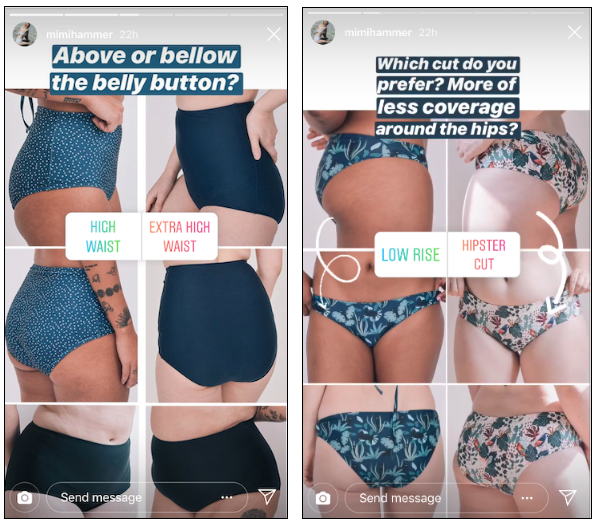 Mimi & August running Instagram polls
Mimi & August running Instagram pollsCreating an Instagram poll is very easy, by the way. You simply:
- Create a new Story by tapping the “+” icon and choosing “story”
- Add/record a photo or video
- Choose the sticker icon (square smiley) at the top of the screen
- Find and select the “poll” sticker
- Fill in the question for your poll and add answer options
- Share your story
Keep an eye on the results for some quality insights into an audience of highly engaged followers.
Facebook and Instagram posts
Did you know you can automatically reply to comments on Facebook and Instagram posts with a private message on Messenger or Instagram DM? The feature is called Comment-to-Messenger - the Instagram version is launching somewhere in the coming months. It's a great way to start conversations and activate your Facebook and Instagram posts.
On Messenger, you can then automate conversations and turn them into an automated survey or quiz, for instance. These private conversations are the perfect way to collect zero-party data from your audience, as they’re low-barrier, conversational and direct.
And did we mention they’re end-to-end encrypted?
Here’s an example of a workflow that lets you collect zero-party data directly from a Messenger conversation:
 Collecting zero-party data with Comment-to-Messenger surveys
Collecting zero-party data with Comment-to-Messenger surveysThe example above shows relational data which you might already know if the person you’re speaking to is an existing customer. You can design conversational surveys that capture much more valuable information, like sizes, preferences, or anything else you can think of.
Want to see one of these conversation flows in action? Try this direct link to a talent acquisition survey in Messenger.
Asking people to fill out a survey in an email is another very simple and effective way to collect zero-party data. Look at how Shopify incentivizes customers to give feedback in this email:
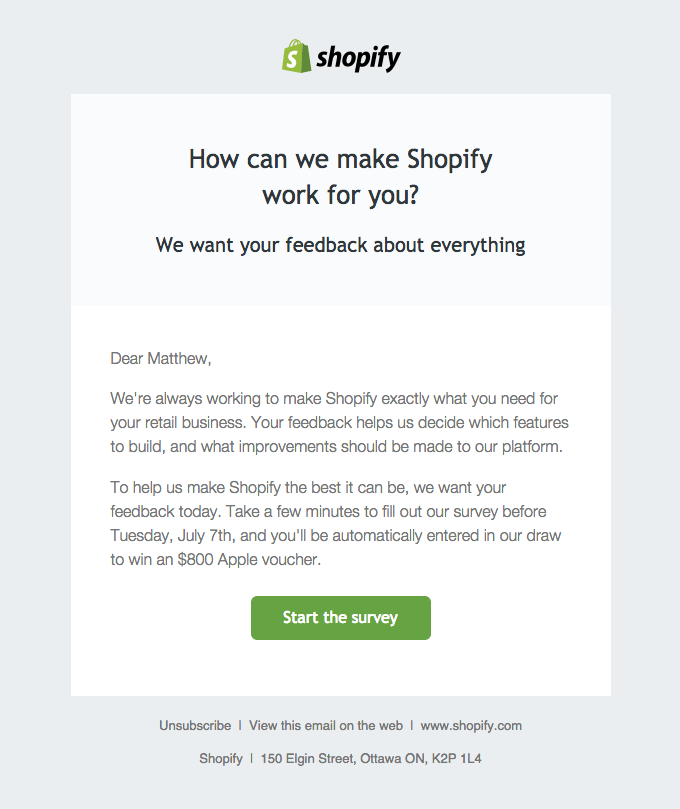 Sending out surveys via email is easy to set up
Sending out surveys via email is easy to set upSetting up this email can be done in minutes, and is the perfect way to collect zero-party data.
Simple, voluntary and self-reported insights from your customers. Even more valuable, since the customers taking the effort to fill out this survey are the ones that trust your business the most.
Omni Opt-in Alerts
What if we told you that you could collect zero-party data by letting your customers opt in to receiving all types of alerts on messaging apps?
If you run a successful online store, there might be times when your products go out of stock, for example. By letting customers opt in to a one-time notification when the product is back in stock, you’re building a high interest list of engaged customers.
Using ShopPop’s Omni Opt-in tools, you can let customers choose whether they want to receive a notification on messaging apps like Messenger, WhatsApp and (soon) Instagram DM. Automate the back-in-stock notification to go out the moment you restock the product in your store.
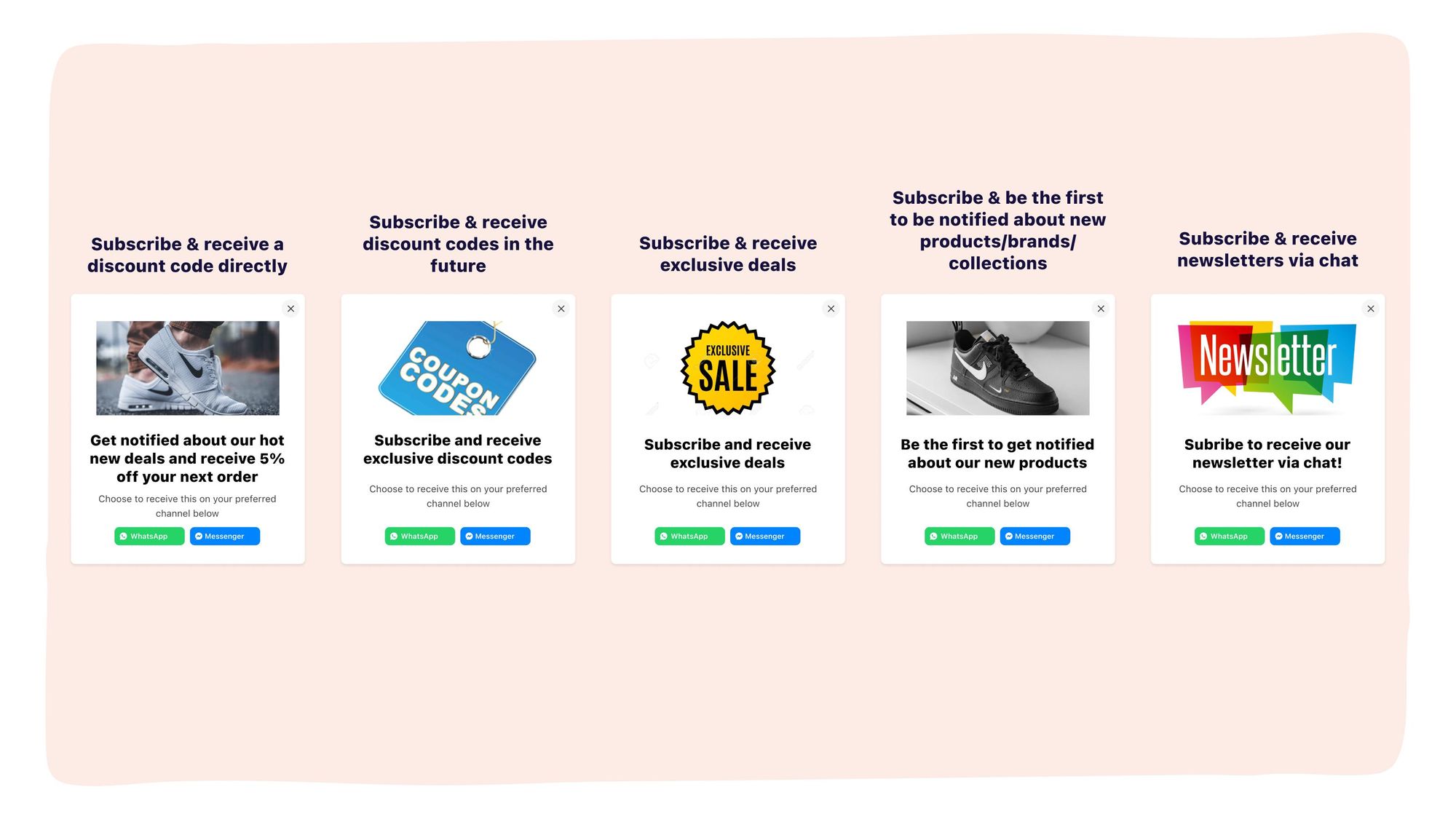 Use cases for Omni Opt-in alerts
Use cases for Omni Opt-in alertsApart from back in stock alerts, there are a bunch of other store alerts you can set up using the Omni Opt-in tool. We already mentioned collection alerts and sale alerts, but you could even let users opt in to DM newsletters, price drops, pre-order alerts or (future) discount codes.
For DTC brands, building these high signal lists gives you a wealth of zero-party data about your audience. And it’s all collected in a voluntary, consent-based way. How’s that for a customer-centric data collection model?
Would you also like to provide your customers with personal, relevant and memorable messaging experiences, while respecting their data privacy rights? Get started with zero-party data collection using ShopPop’s messaging tools.
Or why don't you connect with ShopPop directly through Messenger at https://m.me/shoppophq